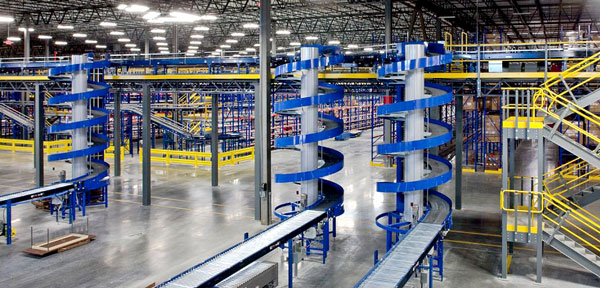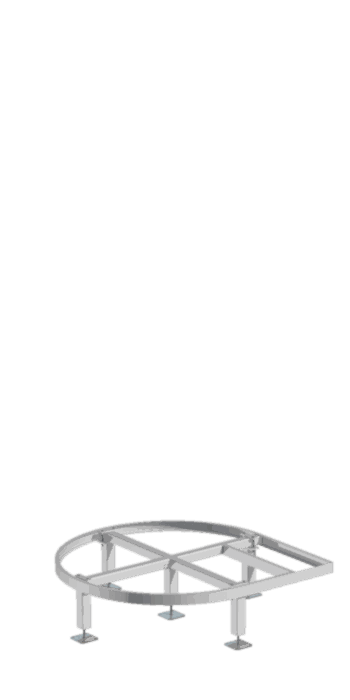Is your facility bursting at the seams with racks, pallets, and equipment, leaving you wondering how to squeeze in a new conveyor line? You’re not alone.
Many operators face a constant struggle to optimize their layouts without expanding the physical footprint. That’s where conveyor solutions for tight spaces can truly shine—especially when you look vertically.
 Rethinking Floor Plans: Going Up Instead of Out
Rethinking Floor Plans: Going Up Instead of Out
Traditional conveyor lines spread out horizontally, claiming a lot of your precious floor space. If your building is already jam-packed, you may not have the room for long belts and complex winding paths. Spiral conveyors offer a vertical approach that effectively frees up your floor. By moving products upward (or downward) in a corkscrew motion, you can streamline material flow without sacrificing aisles or storage areas.
In many cases, simply reconsidering how to use vertical real estate can open a world of new possibilities. Think of it like building a high-rise in the middle of a crowded city—by going up, you can expand your operational capacity without requiring additional land.
 Why Spiral Conveyors Excel in Tight Spaces
Why Spiral Conveyors Excel in Tight Spaces
For facilities grappling with limited room, spiral conveyors are a unique type of conveyor solutions for tight spaces because they combine vertical lifting with a small footprint. Rather than weaving around corners and overloading the floor, the spiral design coils upward, saving space while maintaining a steady product flow.
Employees often find these systems simpler to navigate, as fewer transfer points mean fewer pinch points where products can jam or slow down. The result? A clearer work environment where people and goods can move around more efficiently.
 The Edge of Modular Design
The Edge of Modular Design
Welded conveyors might be fine for some situations, but what happens when your needs evolve or you want to reconfigure your layout? A modular spiral conveyor offers the flexibility to adapt over time. Each section can be added or removed as needed, allowing you to change the conveyor’s height or angle without tearing down the entire line.
This adaptability also helps streamline maintenance. If one segment needs repair, you can swap it out without halting the entire system. Ultimately, that means less downtime and a more resilient operation.
Real-World Applications
- Warehouses with Limited Aisle Space
Picture a warehouse packed with storage racks, forklifts zooming by, and minimal room for a conveyor system. A spiral conveyor tucked in a corner can lift products to mezzanine levels or drop them down to shipping lanes. With its slim vertical profile, it won’t block key traffic routes. - Manufacturing Plants Needing Multi-Level Movement
In manufacturing, efficiency hinges on a smooth flow between stages—like assembly, quality checks, and packaging. By using a vertical conveyor, items can quickly transition between floors, saving employees from hauling them on elevators or manual lifts. - Distribution Centers Facing Seasonal Surges
Many distribution centers encounter peak periods where throughput needs skyrocket. A modular spiral conveyor can be expanded or reconfigured to handle higher volumes without having to knock down walls or rent extra warehouse space.
Planning Tips for Conveyor Solutions in Tight Spaces
- Perform a Thorough Site Audit
Before installation, assess your facility’s dimensions—both horizontally and vertically. Identify any overhead obstructions, such as lighting fixtures or piping, that could affect conveyor placement. - Consult Experts Early
Engage with conveyor specialists who understand conveyor solutions for restricted space. They can guide you on the appropriate radius, pitch, and speed to meet your operational goals. - Leave Room for Maintenance
Even space-saving conveyors require routine checkups. Plan enough clearance around the spiral so technicians can access motors, belts, or sensors without major disruptions. - Consider Future Growth
If you expect to scale up, opt for a modular conveyor design that lets you expand. This forward-thinking approach can help you accommodate evolving product lines or seasonal spikes.
The Bottom Line: Vertical Space as Your Secret Weapon
Facilities frequently underestimate their vertical capacity. When ground-level real estate is maxed out, looking upward can be an effective strategy. Spiral conveyors leverage this untapped space, alleviating congestion and providing a continuous flow of goods.
By choosing conveyor solutions, such as modular spiral conveyors, you don’t just address the immediate challenge of cramped layouts—you position your facility for scalable, future-forward growth.
If you’re ready to discover how our conveyor solutions can help you optimize your floor plan, reach out to Ryson. Our team of experts will guide you toward the perfect modular spiral conveyor design, ensuring you maximize efficiency without needing extra square footage.



